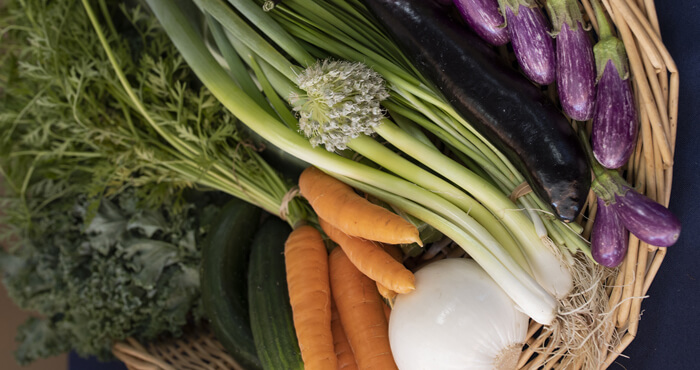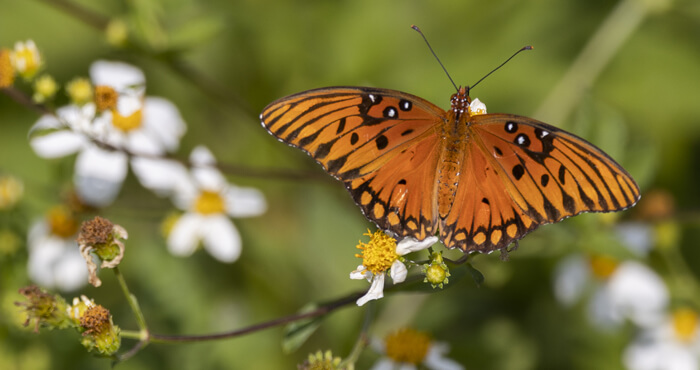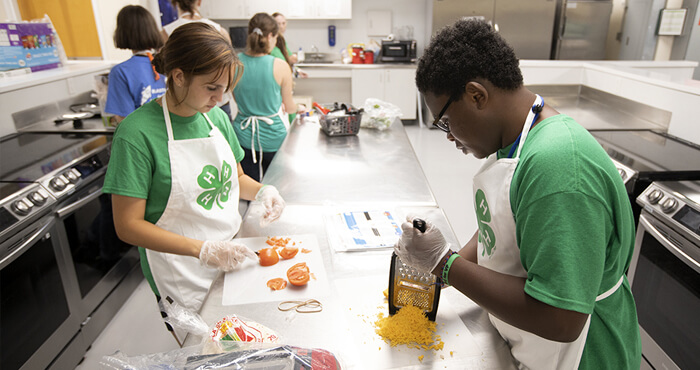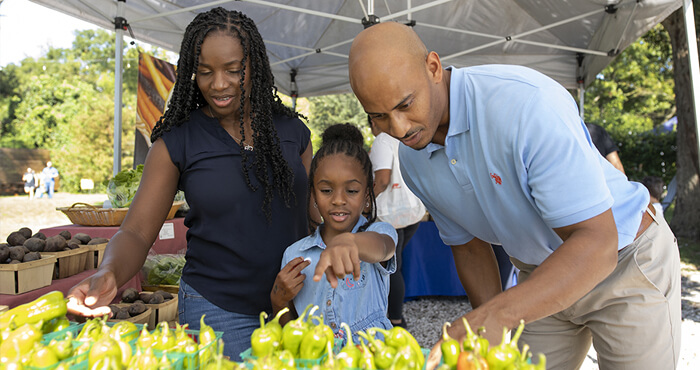
Vegetable Gardening
Growing your own vegetables offers many health benefits. From exercise and mental clarity to fresh air and economic savings, vegetable gardening can be easy if you know the appropriate dates for planting.
While this guide provides recommendations primarily for home gardens, the information may be useful for container, community, and market gardens, as well as others.
Steps of Vegetable Gardening
Locate a Site
Choose a spot on a well drained site close to a source of water and in a location that receives at least six hours of direct sunlight daily. Vegetables may also be included in the landscape among ornamental plants.
If possible, rotate your garden site each year to help control soil diseases and other pests.
Plan the Garden
Before planting, draw a garden plan that includes the name, location, and planting date(s) of the vegetables you want to grow. Use the planting guide table and its list of suggested varieties in the "Florida Vegetable Gardening Guide."
Make a list of supplies and purchase seeds early if you intend to grow your own transplants. If the vegetables are difficult to transplant, they should be seeded directly into the garden.
Prepare the Soil
Improve the soil with additions of organic matter at least three weeks before planting. At planting time, rework the soil into a smooth, firm surface.
Apply Organic Matter
Most Florida soils benefit from adding organic matter, such as animal manure, rotted leaves, compost, commercial soil mixes, and cover crops. Un-composted organics should be mixed in the soil well in advance of planting, preferably at least a month before seeding; composted organics may be applied at planting time.
Spread 25–100 pounds of compost or composted manure per 100 square feet.
Consider Cover Crops
Green manure is fresh plant material turned into the soil. During the off-season, it is beneficial to plant and till in green manure crops. The following cover crops are recommended: cowpea, velvet bean, soybean, and sunflower in summer; cereal rye, crimson clover, and Austrian winter pea in winter.
Adjust Soil pH
Soil pH determines how available nutrients are to plants. The best pH range for vegetable gardens on sandy soil is between pH 5.8 and 6.3. If your soil pH is between 5.5 and 7.0, you will not need to adjust your soil pH.
If your soil pH is below 5.5 (acidic), apply lime at a rate recommended by a reliable soil testing facility, such as the IFAS Extension Soil Testing Laboratory. (Caution: Applying lime when it is not needed may cause plant nutritional problems.) Lime is best applied 2–3 months before the garden is planted.
If your soil pH is naturally above 7.0 (alkaline), where limestone, marl, or shells are present, there is no practical way of permanently lowering soil pH. Use a fertilizer that contains micronutrients. If the high pH is a result of previous over-liming, applying granular sulfur (1 lb/100 sq ft) will lower soil pH.
Compost
Create your own compost with yard wastes. Composting is easy to do and yields a manure-like, organic fertilizer and soil conditioner, which benefits Florida's sandy native soils.
Read "Compost Tips for the Home Gardener" to learn about composting methods.
Fertilize
Unless large quantities of organic materials are applied, fertilizer is usually needed in Florida gardens. Gardeners can use commonly available fertilizer grades, such as 6-6-6 or 10-10-10. However, some Florida soils contain adequate phosphorus (the middle number), and additional amounts should not be added since phosphorus is a pollutant in surface water. A soil test can determine whether phosphorus is needed.
Refer to Fertilizing in the "Florida Vegetable Gardening Guide" for fertilizer types and rates. Broadcast fertilizer over the entire garden plot before planting. In addition, during the growing season, it may be necessary to apply fertilizer alongside planting rows.
Plan Irrigation and Drainage
Vegetables need adequate soil moisture to grow and produce, but cannot tolerate standing water from excessive rainfall or irrigation. The amount of watering a plant needs depends on the age of the crop and your soil type.
Young plants need frequent, light irrigation; maturing crops need more water but less often. Sandy soils demand more frequent irrigation than clay, muck, or amended soils. Conserve water by using mulch, organic matter, and techniques such as drip irrigation.
Pest & Disease Management
Good cultural practices can keep severe pest and disease problems at bay. Also remember that the presence of a few pests does not mean an infestation; most plants can stand a 10%–20% loss of leaves without a loss of potential yields.
Non-Chemical Approaches
- Follow the recommended planting dates listed for each vegetable.
- Rotate vegetables each year so that the same vegetable or vegetable family members (Table 3 in the "Florida Vegetable Gardening Guide") are not planted repeatedly in the same areas.
- Remove weeds around the garden. Chemical weed control is not recommended.
- Choose vegetable varieties with resistance or tolerance to nematodes and the diseases common in your area.
- Purchase transplants that are free of insects and disease symptoms (such as leaf spots or blights). Avoid transplants that are already flowering.
- Use lightweight row covers to provide a good barrier against insects. Remove when plants start flowering.
- Monitor or scout the garden twice a week for pest problems.
- Learn to identify beneficial insects (praying mantis, spiders, big-eyed bugs/assassin bugs, lady beetles, and all wasps).
- Plant flowers in the vegetable garden. Flowers provide nectar and pollen that attract beneficial insects.
- Harvest crops as soon as they are ripe. Allowing over-ripe fruits to stay on the plant often invites more insect problems.
- Remove unproductive plants from the garden as soon as possible and compost or dispose of them.
- Reduce nematode populations temporarily through soil solarization.
- Add organic matter to the soil to reduce nematode populations.
Using Pesticides Wisely
If you choose to use pesticides, follow label directions carefully.
- Learn to properly identify garden pests and use chemicals only when a serious pest problem exists. (Remember, plants can take a 10%–20% loss of leaves without a loss of potential yields.)
- Not every pesticide can be used on every vegetable and some pesticides cannot be used on vegetables at all. Make sure the vegetable and the pest are both on the label before you purchase a product.
- Follow the label directions for measuring and mixing pesticides. Pay attention to any "pre-harvest interval"—this is the time that must elapse between application of the pesticide and harvest.
- Follow all safety precautions on the label, and keep all people and pets out of the area until the spray has dried.
- Apply insecticides late in the afternoon or in the early evening when bees and other pollinators are less active.
- To reduce spray burn, make sure the plants are not under moisture stress. Water if necessary and let leaves dry before spraying.
- Products with metaldehyde as the active ingredient are extremely toxic to animals, including dogs and wildlife, which may be attracted to the bait.
More Information
For tables, lists, and more detailed information on the ideas presented here, look at the "Florida Vegetable Gardening Guide."
Also remember that microclimates and soil conditions vary within regions. Your local Extension agent is the best resource for helping you determine what plants, gardening methods, and pest control options are best for your area.
Adapted from:
Sydney Park Brown, et al, "Florida Vegetable Gardening Guide" (SP103), Horticultural Sciences Department (revised 10/2015 and 01/2016).
Resources
Other UF/IFAS Sites
- Gardening Solutions
- Entomology and Nematology Department
- Environmental Horticulture Department
- FAWN: Florida Automated Weather Network
- Florida-Friendly Landscaping™ Program
- Florida Master Gardener Program
- IPM Florida
- Pesticide Information Office
UF/IFAS Publications
State & Federal Agencies
- Florida Department of Agriculture and Consumer Services (FDACS)
- Florida Department of Environmental Protection (FDEP)
- Florida Energy Systems Consortium (FESC)
- U.S. Environmental Protection Agency (EPA)
- USDA Plant Hardiness Zone Map--U.S. National Arboretum
Organizations & Associations
- American Community Gardening Association
- American Horticultural Society
- Florida Native Plant Society
- Florida Nursery, Growers and Landscape Association (FNGLA)
- North American Native Plant Society
Other Sites & Publications
UF/IFAS Mobile Web Apps





.jpg)

.jpg)
